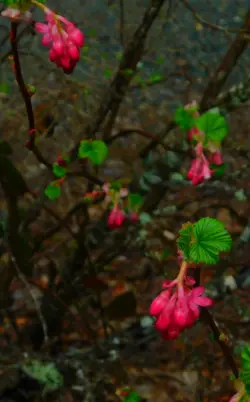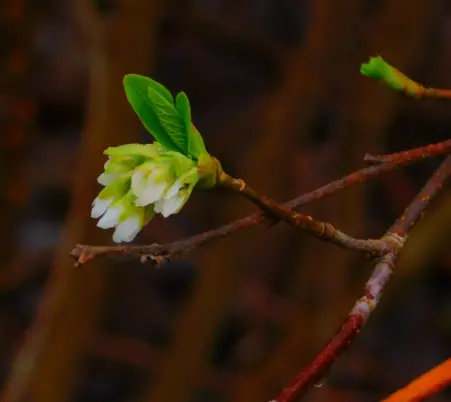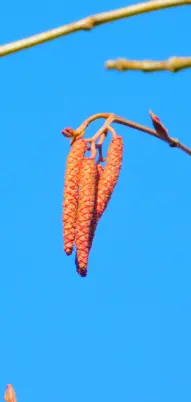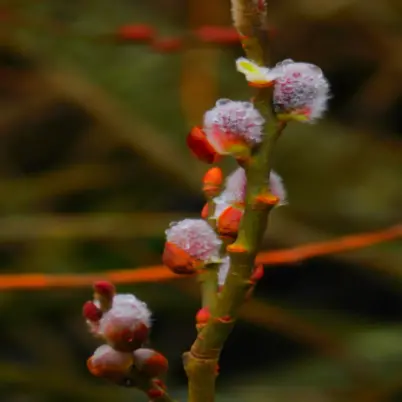Lakewood’s Fashionably Late Bloomers
by Marcia Wilson

Colors of Winter
March 19 is the first day of spring, but there is no need to wait for spring blooms. If you know where to look, you can enjoy four of the most iconic flowers of winter in the South Puget Sound.
Pink Winter Currants
The red-flowering Currant is a welcome source of food for the hummingbirds that overwinter in Pierce County. Soil temperature is key in generating the new growth, which is why some bushes on campus will be ahead of bushes elsewhere. This early-bird of a bloom has led to it being called the pink winter currant.
Red-flowering currants became a sensation when they were first brought to Europe, and botanists enthusiastically bred them to be even more beautiful. These are the strains a Tacoman is likely to see in a greenhouse or floral arrangement. Despite the love Europe had for this shrub, it is considered bad luck to bring the blooms inside the house in the United Kingdom.
Plum Wild: The Osoberry

The Osoberry was once called the Indian Plum for generations, but it isn’t a plum. It isn’t even in the same genus, the Prunus. It belongs to its own genus the Oemleria. This shrub is culturally significant to the Native Americans who share its traditional range, and is a valuable source of food and shelter for wildlife. Osoberry rarely grows taller than 12 feet tall. Do not be fooled at the delicate white petals and tender green leaves: this is a hardy survivor. It quickly recovers from wildfires, floods, and even volcanic ashfall. Sadly, having lots of shrubs do not guarantee lots of fruit; both male and female shrubs are needed for pollination. CPTC is fortunate that there is a good ratio of both in its Garry Oak grove.
Among gardeners and botanists there is a casual rule of thumb about trees and woody shrubs: First to leaf out, first to leaf drop. In the case of the osoberry this is a fact. Few shrubs will beat the osoberry to the first bloom and leaf-out of the year, and they will start dropping papery, gold-colored leaves in late summer.

Red Alder: Red Giants
Alder comes from an old linguistic root meaning “red/brown”. The female flowers are tiny, but the male catkins are more easily seen. Catkins flowering spikes on certain winter blooming trees: Alders, birch, hazelnut, and willows are the best known. The word catkin tracks to the Dutch katteken, because they resemble the fluffy tails of kittens. This is also why blooming willows are generically called pussywillows.
A mature alder can be anywhere from 70 to 130 feet tall. This makes it difficult for humans to admire the beauty of the catkins. Look at the color of the branche-tips in good light: they and the catkins will be reddish against the yellows, browns, and grays of other trees.
Alders can confuse the eye at times because it resembles birch in many ways. Beaver will chew down both, but if the exposed wood turns a bright shade of red-orange it is an alder. Birch wood remains pale.

Where There’s a Willow, There’s a Way

The Salix for the Salix willows of the marsh is based on two Celtic words meaning “near water”. The willow clusters of the college wetlands are an interesting sight and frequently humming and buzzing with birds, insects, and small mammals like mink, mice, shrews and voles.
This month the students in higher chemistry classes studied the manufacturing of aspirin in the lab. The source material? Salicylic Acid. This was originally derived from meadowsweet and willow bark. It was one of the first synthetic drugs ever made.
Humans have enjoyed the beauty of willows for millennia. Pussywillow branches will bloom even in the heart of winter if they are placed in water. Kept in the water long enough, the branches will grow into rooted cuttings. Willow water contains rooting hormones such as the aforementioned salicyclic acid and indolebutyric acid. This was a valuable resource in the past since the rooting water can be used for other plants.
Thus, the emergent spring growth was unmistakable proof of winter’s end. In colder climates the pussywillows were a substitute for palms in Palm Sunday observances. The willows are also a treasured cultural emblem for the Lunar New Year. In Iran the pussywillow are such a welcome emblem for the Nowruz (New Year) festivities, that a sweet candy is made from the soft buds.
Peek between the raindrops for these spots of color, for these (almost) spring showers bring may flowers.